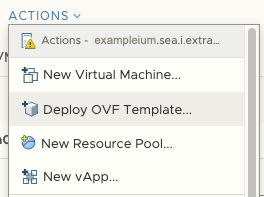Deploy the IDS sensor with VMware
Intrusion Detection System (IDS) sensors integrate with packet sensors to generate detections based on industry-standard IDS signatures. This guide explains how to deploy the IDS sensor with VMware.
Before you begin
- You must have familiarity with administering VMware. The images in this guide are from VMware version 6.7, and some of the menu selections might have changed.
- We recommend that you upgrade to the latest patch for the vSphere environment to avoid any known issues.
This guide explains how to deploy the following ExtraHop virtual sensors on the VMware ESXi/ESX platform:
- IDS 6280v
Virtual machine requirements
Your hypervisor must be able to support the following specifications for the virtual sensor.
- VMware ESX/ESXi server version 6.5 or later
- vSphere client to deploy the OVF file and to manage the virtual machine
- (Optional) If you want to enable packet captures, configure an additional storage disk during deployment
- The following table provides the server hardware requirements for each Discover appliance model:
| Sensor | CPU | RAM | Disk |
|---|---|---|---|
| IDS 1280v | 4 processing cores with hyper-threading support, VT-x or AMD-V technology, and 64-bit architecture. Streaming SIMD Extensions 4.2 (SSE4.2) and POPCNT instruction support. | 8 GB | 46 GB or larger disk for data storage (thick-provisioned) 250 GB or smaller disk for packet captures (thick-provisioned) |
| IDS 6280v | 16 processing cores with hyper-threading support, VT-x or AMD-V technology, and 64-bit architecture. Streaming SIMD Extensions 4.2 (SSE4.2) and POPCNT instruction support. | 64 GB | 1 TB or larger disk for data storage (thick-provisioned) 500 GB or smaller disk for packet captures (thick-provisioned) |
- Make sure that the VMware ESX/ESXi server is configured with the correct date and time.
- Always choose thick provisioning. The ExtraHop datastore requires low-level access to the complete drive and is not able to grow dynamically with thin provisioning. Thin provisioning can cause metric loss, VM lockups, and capture issues.
- Do not change the default disk size on initial installation. The default disk size ensures correct lookback for ExtraHop metrics and proper system functionality. If your configuration requires a different disk size, contact your ExtraHop representative before you make any changes.
- Do not migrate the VM. Although it is possible to migrate when the datastore is on a remote SAN, ExtraHop does not recommend this configuration. If you must migrate the VM to a different host, shut down the virtual sensor first and then migrate with a tool such as VMware VMotion. Live migration is not supported.
| Important: | If you want to deploy more than one ExtraHop virtual sensor, create the new instance with the original deployment package or clone an existing instance that has never been started. |
Network requirements
| Sensor | Management | Monitor |
|---|---|---|
| IDS 6280v | One 1 GbE network port is required (for management). The management interface must be accessible on port 443. The management interface can be configured as an additional ERSPAN/RPCAP target. | A 10 GbE network port is recommended for the physical
port mirror. The physical port mirror interface must be connected to
the port mirror destination on the switch. The VMware ESX server
must support network interface drivers. Optionally, you can configure 1-3 1 GbE network ports to receive packet monitor traffic. |
| Important: | To ensure the best performance for initial device synchronization, connect all sensors to the console and then configure network traffic forwarding to the sensors. |
| Note: | For registration purposes, the virtual sensor requires outbound DNS connectivity on UDP port 53 unless managed by an ExtraHop console. |
Deploy the OVA file through the VMware vSphere web client
ExtraHop distributes the virual sensor package in the open virtual appliance (OVA) format.
Before you begin
If you have not already done so, download the ExtraHop virtual sensor OVA file for VMware from the ExtraHop Customer Portal.Configure a static IP address through the CLI
The ExtraHop system is configured by default with DHCP enabled. If your network does not support DHCP, no IP address is acquired, and you must configure a static address manually.
| Important: | We strongly recommend configuring a unique hostname. If the system IP address changes, the ExtraHop console can re-establish connection easily to the system by hostname. |
- Access the CLI through an SSH connection, by connecting a USB keyboard and SVGA monitor to the physical ExtraHop appliance, or through an RS-232 serial (null modem) cable and a terminal emulator program. Set the terminal emulator to 115200 baud with 8 data bits, no parity, 1 stop bit (8N1), and hardware flow control disabled.
- At the login prompt, type shell and then press ENTER.
- At the password prompt, type default, and then press ENTER.
-
To configure the static IP address, run the following commands:

Thank you for your feedback. Can we contact you to ask follow up questions?